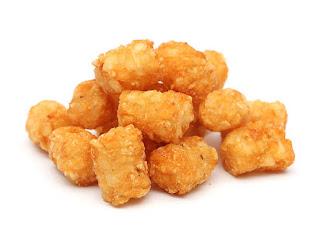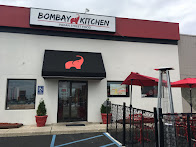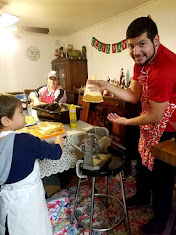Comfort Food in Springfield, OH (No, cats and dogs are not being eaten!) Nov. 2024
Comfort food sounds like a fun topic, but kind of trivial in the larger scheme of thing—kind of like perceptions of folklore. That’s a mis-judgement, however. The task of folklore as a discipline is to illuminate and elucidate the meaningfulness of the everyday and overlooked. We express who we are, what we value, and our personalities and circumstances through food, oftentimes without even realizing it. Comfort food is similar. It reflects our childhoods, our family backgrounds, our identities and values. Someone’s choice of what dishes bring them comfort tells a whole lot about them.
So, when the public library in Springfield, Ohio asked me to give a talk about comfort food, I said yes. The invitation came after the presidential debate when one nominee known for deception and making up and repeating outrageous lies claimed that illegal Haitian immigrants in the town of Springfield, Ohio were eating cats and dogs. The claims were completely unfounded, and significantly, the immigrants were there not only legally but had been invited by the mayor to add to the much-depleted work force. The claims, nonetheless, were repeated by trolls on social media and by those buying into the magga worldview of fear, bigotry, and bullying for whatever reason their small hearts came up with.
First, the talk on comfort food. The thing about comfort food is that it reflects a very American morality that is attached to self-control around eating. We’re not supposed to enjoy food—or other "the pleasures of the flesh”—too much, so if we don’t have the “perfect” body size and weight it represents our own failure as an individual to have will power and control ourselves. Gluttony used to be considered one of the top sins, but has been thrown by the wayside unless it affects how we look. (It’s become a virtue when it comes to money or material possessions, but that’s another story.)
The term first showed up in 1966 in a newspaper column by Dr. Joyce Brothers to explain the “obesity epidemic.” People were using it as a “rhetorical strategy” to justify eating “unhealthy” foods but wanted to avoid the shame and guilt attached to those foods. In the early 2000s, medical sociologists and nutritional scientists, namely Julie Locher, began studying the phenomenon and identified four emotional needs it fulfilled: nostalgia, convenience, physical comfort, indulgence. A fifth was later added—belonging.
When we start going through those five needs and the different foods that work as comfort for each of us, we can see how varied we all are. Even two people in the same family can have different comfort foods—we all have our own experiences and reactions to events and people in the past. One person might favor their Polish grandmother’s food; while the other might feel nostalgic about their mother from the deep South.
Talking about comfort food, then, illustrates the vast diversity—and richness—of backgrounds, circumstances, values, and personalities that make up the nation. Why is this important in a city like Springfield, OH? Because this country is made up of diverse individuals,
and even those seeming to share a race, religion, or political affiliation still have their own unique experiences. And that is the true wealth of this country. Its dive
rsity brings in new ideas, new perspectives, new energies, and it should also, if we were encouraged to use our imaginations, help us understand and empathize with other people and their lives.
We all make choices in interpreting what we see, though, and in this moment, the interpretations of a lot of Americans (though not the vast majority, as the numbers are showing us) are based on fear of anyone different. Talking about comfort food can help bring home the idea that we all share some things in common, like the 5 basic emotional needs, but that we also are all drawing on our unique differences to fulfill those—and we still have the freedom to do so. Perhaps conversations like these can help us fight to retain that freedom. (See the references below for more ideas on how to do that.)
By the way, the Haitian restaurant was easy to find. Bright and airy, the servers and cooks were friendly and hospitable (and clean, in case anyone is wondering). I ordered two take-out meals—fried pork with spicy slaw and plantain patties, and black beans with vegetables and rice. Both were delicious! And they are just as “American” as the macaroni and cheese or meatloaf and mashed potatoes the food industry markets as comfort food.
Lucy M. Long. Food as Lens for Exploring Key Concepts in Cultural Differences: A Curriculum Project—Introduction to the Project. Digest: A Journal of Foodways and Culture 10(1): pp. 1-13. Spring 2023.(https://scholarworks.iu.edu/journals/index.php/digest/issue/view/2289
Lucy Long, with Susan Eleuterio and Jerry L. Reed. Keywords: Using Food as a Lens on Cultural Conflict—K12-Curriculum. Digest: A Journal of Foodways and Culture 10(1): 1-39. Spring 2023.(https://scholarworks.iu.edu/journals/index.php/digest/issue/view/2289)
Center for Food and Culture. Keywords: Exploring Cultural Differences Through the Lens of Food K-12: Curriculum Guide.
https://foodandculture.org/keywords-exploring-cultural-differences-through-the-lens-of-food-k-12-curriculum-guide/
Janet A. Flammang. Table Talk: Building Democracy One Meal at a Time. (University of Illinois Press, 2016)




























